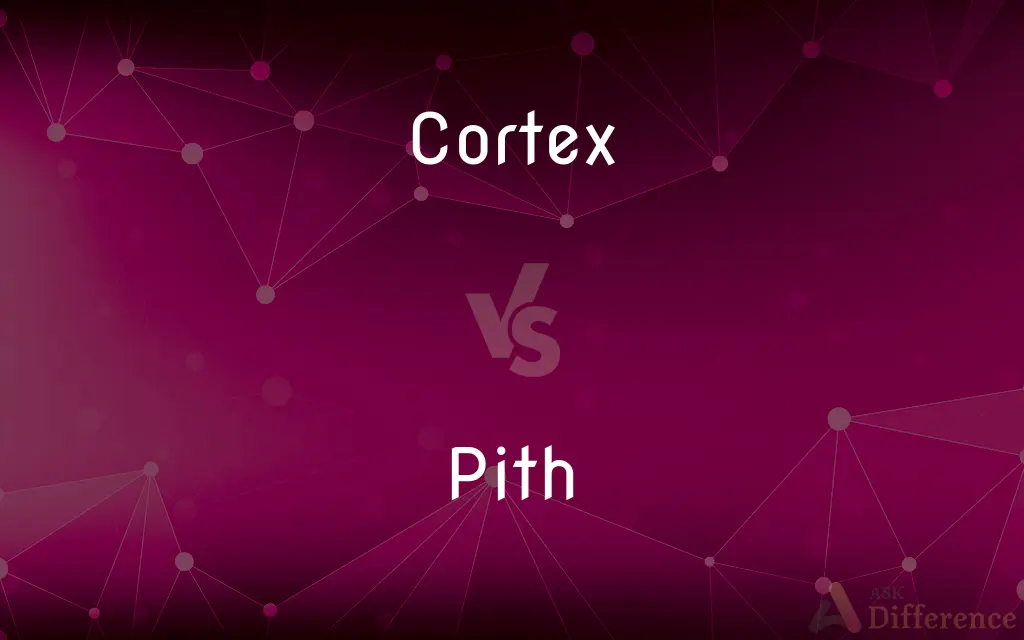Cortex vs. Pith — What's the Difference?
Edited by Tayyaba Rehman — By Urooj Arif — Updated on April 8, 2024
The cortex is the outer layer of a plant stem, involved in photosynthesis and storage, while the pith is the central core, important for nutrient storage.

Difference Between Cortex and Pith
Table of Contents
ADVERTISEMENT
Key Differences
The cortex of a plant is the outer layer of tissue between the epidermis (outermost layer) and the vascular tissue. It is primarily involved in the storage of food and nutrients and, in some plants, photosynthesis. This layer is made up of parenchyma cells, which are often photosynthetically active, especially in young stems and in species with green, herbaceous stems. On the other hand, the pith is located at the center of the stem or root and is also composed of soft, spongy parenchyma cells. The pith's primary role is the storage of nutrients and, in some cases, water. It plays a crucial part in the plant's internal transport system but does not participate directly in photosynthesis.
While the cortex is known for its structural support to the stem or root, assisting in the plant's mechanical strength and sometimes involved in the transport of substances across the stem, the pith serves as a storage area and provides the plant with structural integrity. The presence of the cortex around the periphery helps in maximizing the area for light absorption in photosynthetic parts, whereas the centrally located pith is strategically placed to efficiently store and supply nutrients to the rest of the plant.
In terms of composition, the cortex may contain various specialized structures such as sclerenchyma fibers for support and collenchyma cells for flexibility and strength, making it heterogeneous in structure. In contrast, the pith is generally more homogeneous, primarily consisting of parenchyma cells, and may become lignified or hollow in some plant species as they age.
The development of the cortex and pith is integral to plant growth; the cortex expands and differentiates to support secondary growth in woody plants, contributing to the thickness of the stem. The pith, while initially playing a vital role in the young plant by storing nutrients, may diminish in size or importance in older sections of woody plants, sometimes even disintegrating to leave a hollow center.
Both the cortex and the pith are essential for the plant's overall health and development, with the cortex acting as a protective and supportive layer that also participates in metabolic activities, and the pith primarily serving as a nutrient reservoir. These differences highlight the diverse strategies plants employ to store nutrients, support structural integrity, and carry out metabolic functions.
ADVERTISEMENT
Comparison Chart
Location
Outer layer of the stem or root, between the epidermis and vascular tissue.
Central core of the stem or root.
Function
Photosynthesis, storage of food and nutrients, mechanical support.
Storage of nutrients, structural support.
Composition
Parenchyma cells, may include sclerenchyma fibers and collenchyma cells.
Primarily parenchyma cells, can become lignified or hollow.
Role in Growth
Supports secondary growth in woody plants, may become thicker.
May diminish or disintegrate in older plants.
Involvement in Photosynthesis
Often photosynthetically active in young stems and herbaceous plants.
Does not participate in photosynthesis.
Compare with Definitions
Cortex
Assists in the transport of substances across the stem.
Substances move through the cortex to reach the plant's vascular system.
Pith
The pith is the central core of a plant stem or root, important for nutrient storage.
The tree's pith was examined for signs of disease.
Cortex
The cortex is the outer layer of a plant stem or root involved in nutrient storage and support.
The plant's cortex was visibly damaged, affecting its growth.
Pith
Provides structural integrity to the plant.
The pith ensures the stem remains upright and strong.
Cortex
It plays a key role in photosynthesis in some plants.
In herbaceous stems, the cortex contributes to the plant's photosynthesis.
Pith
Consists mainly of parenchyma cells.
The soft, spongy nature of the pith is due to its parenchyma cell composition.
Cortex
Contains various cell types for structural support.
The cortex's collenchyma cells provide the stem with flexibility.
Pith
May become lignified or hollow in older plants.
In some species, the pith becomes hollow as the plant matures.
Cortex
Expands during secondary growth.
The tree's cortex thickened, providing more support.
Pith
Plays a crucial role in young plants.
The young plant relies on the pith for nutrient storage during early growth.
Cortex
The outer layer of the cerebrum (the cerebral cortex), composed of folded grey matter and playing an important role in consciousness.
Pith
Pith, or medulla, is a tissue in the stems of vascular plants. Pith is composed of soft, spongy parenchyma cells, which in some cases can store starch.
Cortex
An outer layer of tissue immediately below the epidermis of a stem or root.
Pith
The spongy white tissue lining the rind of oranges, lemons, and other citrus fruits.
Cortex
The outer layer of an internal organ or body structure, as of the kidney or adrenal gland.
Pith
The essence of something
The pith and core of socialism
Cortex
The outer layer of gray matter that covers the surface of the cerebral hemisphere.
Pith
Vigour and conciseness of expression
He writes with a combination of pith and exactitude
Cortex
(Botany) The region of tissue in a root or stem lying between the epidermis and the vascular tissue.
Pith
Remove the pith from
Peel and pith the oranges
Cortex
An external layer, such as bark or rind.
Pith
Pierce or sever the spinal cord of (an animal) so as to kill or immobilize it.
Cortex
(Cytology) The region of the cytoplasm of a eukaryotic cell that lies just under the plasma membrane and contains a network of actin filaments and associated proteins that determine the shape of the cell.
Pith
The soft, spongy tissue in the center of the stems of most vascular plants, consisting mainly of parenchyma.
Cortex
The outer layer of an internal organ or body structure, such as the kidney or the brain.
Pith
The soft inner substance of a feather or hair.
Cortex
The tissue of a stem or root that lies inward from the epidermis, but exterior to the vascular tissue.
Pith
The spinal cord.
Cortex
(archaeology) The outer surface of a piece of flint.
Pith
The essential or central part; the heart or essence
The pith of your argument is controversial.
Cortex
Bark, as of a tree; hence, an outer covering.
Pith
Strength; vigor; mettle.
Cortex
Bark; rind; specifically, cinchona bark.
Pith
Significance; importance
Matters of great pith.
Cortex
The outer or superficial part of an organ; as, the cortex or gray exterior substance of the brain.
Pith
To remove the pith from (a plant stem).
Cortex
The layer of unmyelinated neurons (the gray matter) forming the cortex of the cerebrum
Pith
To sever or destroy the spinal cord of, usually by inserting a needle into the vertebral canal.
Cortex
The tissue forming the outer layer of an organ or structure in plant or animal
Pith
To kill (cattle) by cutting the spinal cord.
Pith
(botany) The soft, spongy substance in the center of the stems of many plants and trees.
Pith
The spongy interior substance of a feather or horn.
Pith
(anatomy) The spinal cord; the marrow.
Pith
(botany) The albedo of a citrus fruit.
Pith
(figuratively) The essential or vital part; force; energy; importance.
The pith of my idea is that people should choose their own work hours.
Pith
(figuratively) Power, strength, might.
Pith
One divided by pi.
Pith
(transitive) To extract the pith from (a plant stem or tree).
Pith
(transitive) To kill (especially cattle or laboratory animals) by cutting or piercing the spinal cord.
Pith
The ordinal form of the number pi.
The pith root of pi is approximately 1.439...
Pith
The soft spongy substance in the center of the stems of many plants and trees, especially those of the dicotyledonous or exogenous classes. It consists of cellular tissue.
Pith
The spongy interior substance of a feather.
Pith
Hence: The which contains the strength of life; the vital or essential part; concentrated force; vigor; strength; importance; as, the speech lacked pith.
Enterprises of great pith and moment.
Pith
To destroy the central nervous system of (an animal, as a frog), as by passing a stout wire or needle up and down the vertebral canal.
Pith
Soft spongelike central cylinder of the stems of most flowering plants
Pith
The choicest or most essential or most vital part of some idea or experience;
The gist of the prosecutor's argument
The heart and soul of the Republican Party
The nub of the story
Common Curiosities
What is the pith?
The pith is the central part of a plant stem or root, mainly involved in storing nutrients and providing structural support.
Can the cortex participate in photosynthesis?
Yes, in some plants, especially young stems and herbaceous plants, the cortex can be involved in photosynthesis.
How does the cortex contribute to a plant's growth?
The cortex supports secondary growth in woody plants, contributes to photosynthesis, and provides mechanical strength.
What is the cortex in a plant?
The cortex is the outer layer of the plant stem or root, involved in nutrient storage, photosynthesis, and providing mechanical support.
Are the cortex and pith made of the same cells?
Both the cortex and pith are primarily made of parenchyma cells, but the cortex may also contain sclerenchyma and collenchyma cells for added support and flexibility.
What is the significance of the cortex in plant protection?
The cortex serves as a protective layer, safeguarding the plant from physical damage and disease.
Why is the pith important for plants?
The pith stores essential nutrients and provides structural integrity, especially in young plants.
Do all plants have a cortex and pith?
Most vascular plants have both a cortex and pith, but their prominence and function can vary significantly among species.
How does the pith affect the plant's ability to stand upright?
The pith contributes to the plant's structural integrity, helping it to remain upright and support the weight of its leaves and branches.
What role does the pith play in older plants?
In older plants, especially woody species, the pith's role may decrease, and it can become hollow, affecting the plant's internal structure.
What happens to the pith as the plant ages?
In older sections of woody plants, the pith may diminish in size, become lignified, or disintegrate, sometimes leaving a hollow center.
Can damage to the cortex affect plant health?
Yes, damage to the cortex can hinder a plant's growth, photosynthesis, and nutrient storage capabilities.
How do environmental conditions affect the cortex and pith?
Environmental conditions can influence the development, structure, and function of both the cortex and pith, impacting the plant's overall health and growth.
How do the functions of the cortex and pith differ?
The cortex is involved in photosynthesis, nutrient storage, and support, while the pith mainly stores nutrients and provides structural support.
Is the cortex visible from the outside of the plant?
No, the cortex is not directly visible from the outside as it is located beneath the epidermis.
Share Your Discovery

Previous Comparison
Descriptor vs. Description
Next Comparison
Contextualization vs. LocalizationAuthor Spotlight
Written by
Urooj ArifUrooj is a skilled content writer at Ask Difference, known for her exceptional ability to simplify complex topics into engaging and informative content. With a passion for research and a flair for clear, concise writing, she consistently delivers articles that resonate with our diverse audience.
Edited by
Tayyaba RehmanTayyaba Rehman is a distinguished writer, currently serving as a primary contributor to askdifference.com. As a researcher in semantics and etymology, Tayyaba's passion for the complexity of languages and their distinctions has found a perfect home on the platform. Tayyaba delves into the intricacies of language, distinguishing between commonly confused words and phrases, thereby providing clarity for readers worldwide.














































